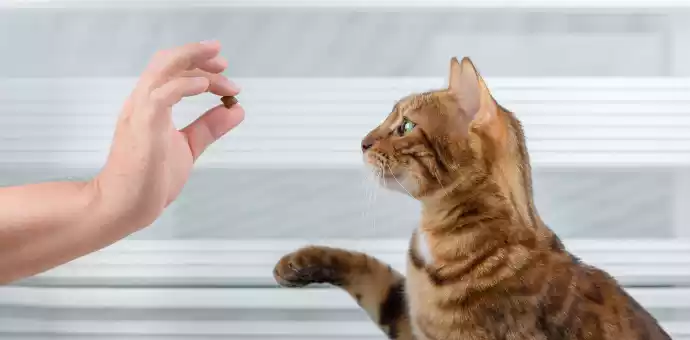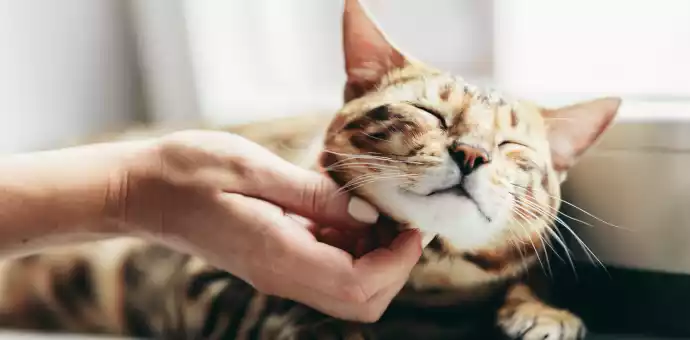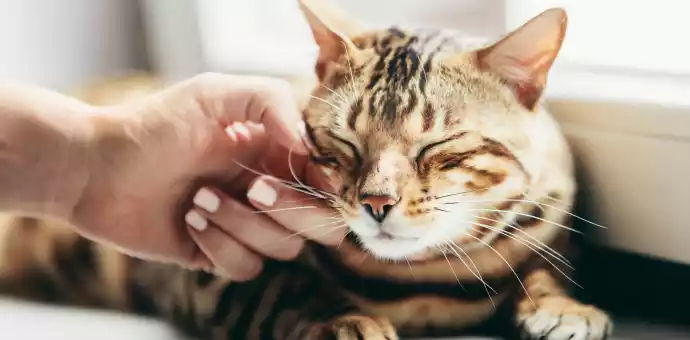If you are the person suffering from cat allergies but still want a feline companion and seeking information on Are Bengal cats hypoallergenic? Then this guide is for you.
Bengal cats are known for their beautiful markings, playful personalities, and surprisingly low allergen levels compared to other cat breeds.
Welcome to our comprehensive guide on Bengal cats and allergies which contains everything you need to know regarding the science behind hypoallergenic cats to invaluable tips on making life easier with your new pet. Follow the fascinating world of Bengal cats and decide if they’re the right feline match for you.
Table of Contents

Introduction
If you are searching for “Are Bengal cats hypoallergenic?” the answer is “NO”.
Although no completely hypoallergenic cats exist, the good news is that Bengal cats make lovely companions for individuals with allergies, and they are less prone to trigger allergies than cats like Norwegian Forest, Persian, and Maine Coons.
Bengal cat personality
Before diving into hypoallergenic cats, let’s start with a quick overview of Bengal cats. They are a hybrid breed created in the 1960s by breeding an Asian leopard cat with a domestic cat. This breeding was done to make a cat with the wild look of a leopard but a domestic temperament.
Bengal cats are typically medium to large, with muscular bodies and short, silky fur in various colors and patterns. They are identified for their high energy level, intelligence, quiet vocal, love to play and affectionate personalities.
What does hypoallergenic cat mean
Hypoallergenic means something with reduced potential for causing an allergy or adverse reaction. If cats have a lower frequency of producing allergen-causing proteins in their urine, saliva, and dander, they are hypoallergenic cats.
It is essential to know that no cat breed is genuinely hypoallergenic; nonetheless, certain cat breeds have been identified as having a lower allergen output.

Are Bengal cats hypoallergenic?
Let’s go right to the point: are Bengal cats hypoallergenic? The answer is they are not. Bengal cats also produce the same allergens as other cat breeds, so if you are highly sensitive to cat allergy, you might also suffer allergic to Bengal cats.
Bengal cats can be excellent companions for allergy-suffering persons because they are less likely to induce allergies than other cat breeds such as Norwegian Forest, Persian, and Maine Coons.
The science behind cat allergies
To understand why some individuals are allergic to cats while others are not, we must look at the science underlying cat allergies attentively.
When a cat grooms itself, it produces a protein called Fel d 1 in its saliva. This protein then sticks to the cat’s fur and skin, and when the cat sheds its fur or scratches itself, it becomes airborne and can induce an allergic reaction in sensitive people.
Why are some people allergic to cats
Allergies develop when our immune system rejects foreign substances by producing antibodies to combat them. When we are exposed to specific allergens our bodies typically trigger an inflammatory response in the nasal passages and lungs, leading to moderate to severe reactions.
Skin irritation indicates an allergic response, although severe symptoms like acute swelling and anaphylaxis are more serious.
Cats and allergies sources
Against the widespread belief that we, as Team PetsPaa, say cat hair is not the cause of all allergic responses. Dander (dead skin) is the most considerable worry for those who suffer from allergies since it is small, airborne, and easily accumulated on clothing and furnishings.
Along with dander, the following things might cause allergies:
- Saliva
- Poop and feces
- Tears
- Sweat
- Sputum or Mucus

Why are Bengal cats less prone to produce allergic reactions
Bengal Cats and Allergies
So, where do Bengal cats fit into this equation? What makes Bengal cats hypoallergenic? While they are not entirely non-allergenic, many people report fewer allergy symptoms when exposed to Bengal cats than with other breeds. This is likely due to a few factors:
- Lower Fel d 1 production: Studies have shown that Bengal cats produce less Fel d 1 protein than other breeds, which may explain why some people experience fewer allergy symptoms around them.
- Grooming habits: Bengal cats are known for their meticulous grooming habits, which may help reduce the amount of allergens in their fur.
- Smaller size: Bengal cats are typically smaller than other breeds, which may produce less saliva and skin flakes overall, further reducing allergen levels.
Of course, it’s worth noting that every cat is different, and some Bengal cats may produce more Fel d 1 protein than others. Additionally, individuals with severe cat allergies may still experience symptoms around Bengal cats, even if they have less allergen overall.
Fel d 1 protein allergy
The main allergen that causes allergic reactions in humans is a protein called Fel d 1, found in a cat’s urine, saliva and skin. When a cat licks itself, it transfers the Fel d 1 protein to its fur, and as the coat sheds, it can become airborne and cause allergic reactions.
Symptoms of being allergic to cats, especially Bengal cats
Bengal cats don’t frequently cause allergies, but if you have a history of allergic reactions to cats or are a new pet parent, you should exercise caution.
It would be good to spend some time (at least a day) with Bengal cats before considering one to see how your body reacts to them.
Extreme allergic symptoms may occur only when someone has asthma or chronic bronchitis. Check the following table lists the most common allergy symptoms:
Mild Symptoms | Severe Symptoms |
Runny nose and sneezing | Vomiting and diarrhea |
Red, watery eyes, and itching | Severe skin rash |
Cough | Chest stiffness or pain |
Restless sleep | Wheezing sound while inhaling |
Swollen under-eyes | Shortness of breath, coughing, or wheezing keeping you from falling asleep |
Is it OK to keep Bengal cat indoors while having allergy
Adopting a Bengal cat shouldn’t be difficult for those with fewer symptoms. Antihistamines like cetirizine and levocetirizine, effective against low-intensity allergies, are available. You may avoid using medications if you take the necessary care and safeguards.
Doctors advise avoiding residing with cats in cases of more severe symptoms. In the worst situations, prolonged exposure can cause severe pain and possibly anaphylactic shock. Sharing a space with a cat would be harmful since avoiding contact with the allergen is the only way to protect yourself.
How to get rid of cat allergies naturally
To get rid of cat allergies naturally, you have to make changes on three different levels to let you and your feline cohabit as peacefully as possible:
- Personal hygiene and cleanliness
- Environmental circumstances
- Care for cats
Personal hygiene and cleanliness
No matter how cute your Bengal cat is, you must find measures to restrict your exposure to them if you have allergies. You ought to:
Cat Side Practice
- Refrain from caressing and stroking your feline (this may not be easy because Bengals are amiable and friendly, but it’s vital)
- Teach them to avoid entering your bedroom.
- Teach them to use the restroom outside or have someone else clean their litter box.
Personal Side Practice
- Removing allergens that may have been transferred to your skin can be possible by washing your hands after petting your cat.
- If you suffer from allergies, consider taking medications like antihistamines to reduce symptoms.
- An allergist consultation may be worth considering if you suffer from severe allergies. Their discussion can involve going over your available choices with you.
If your allergies persist despite following these measures, you must need medication. If you intend to take antihistamines, decongestants, or allergy injections for an extended period, meet a specialist doctor to go with the best course of action.

Environmental circumstances
Keeping your environment clean is crucial to reducing allergy symptoms. Keeping your home clean is essential. Make certain to:
Use of air purifiers
HEPA (high-efficiency particulate air) air purifier design helps quickly eliminate these particles because Fel d1 is airborne and tends to persist. Turn off ordinary fans and air conditioners in locations where your cat frequently visits.
Regular cleaning
Those afflicted with allergies must prioritize cleanliness in their households. Employing frequent vacuuming, dusting, and washing of your feline companion’s bedding is vital to minimizing allergens in the home. Remember to sanitize your hands after handling your cat or tidying their litter box to ensure a healthy environment.
Care for cats
Taking good care of your Bengal cats will benefit both your allergies and their health and lifespan. Pay close attention to the following:
Grooming
While Bengals don’t require as much grooming as other breeds, brushing and cleaning them with a moist cloth can stop loose dander from settling on your furniture and spreading around your house.
Nutrition
A balanced diet keeps your Bengal skin moisturized and in good condition overall. Giving your feline a superior food rich in animal protein will prevent dry and flaking skin.
How can I improve my cats health with a healthy diet
You can’t completely get rid of cat allergies, but a good diet can help your Bengal cat shed less, keeping allergens away from you. A well-balanced diet will minimize dander and moisturize your cat’s skin and hair.
Any feline diet must include these foods:
- Animal protein
- Animal fat

Animal protein
Our feline friends must not only eat meat to survive, but it also helps to develop some following traits such as muscle growth, healthy skin, silky coat.
Healthy skin and a silky coat help to prevent allergens in Bengal cats. ultimately low allergic conditions.
For your Bengal to acquire enough taurine, an essential amino acid necessary for maintaining healthy organ, muscle, and CNS (central nervous system) function, the ideal diet should contain more than 50% animal protein.
Your allergies may worsen if your Bengal gets insufficient animal protein in their diet, which will also impact the condition of their coat. Because felines cannot digest plant proteins, they are not a viable substitute.
Although peas, carrots, and broccoli are neither poisonous nor hazardous to cats, they cannot provide the nutrients required to maintain your feline’s health.
Animal fat
Kittens may get by on animal fat as their secondary energy source. Your Bengal’s skin and coat depend on the fatty acids found in animal fat to remain in excellent shape.
If your Bengal cat is a selective eater who shuns wet, dry, raw, or any other food, test how quickly they’ll chow down on a diet containing enough animal fat. Kittens can’t get enough animal fat, a great flavor enhancer.
To prevent weight gain and associated problems, including obesity and diabetes, keep the fat in your feline’s food below 20%.
What food should Bengals eat never
Avoiding certain nutrients is vital for maintaining coat health as consuming the proper ones. Make certain your cat avoids the following:
- Commercially produced food that contains filler components.
- Foods containing common allergens (beef, wheat, dairy, and related items).
- Toxic components (grapes, coffee, chocolate, or plants from the allium family).

What food is best for Bengals
For healthy, well-hydrated skin and fur, Bengals should consume wet canned food every day. Failure to maintain this balance and overfeeding your feline on kibble can result in the following:
- Flaky skin and poor-quality fur: Dehydration brought on by a lack of moisture can result in the skin losing its elasticity, so wet food is a good choice.
- Weight gain: Since dry food contains a lot of calories. Overindulging can result in obesity, especially in older cats that don’t require as many as young kittens.
- Common feline illnesses: Wet food is good in these conditions as dry food may raise the risk of diabetes, constipation, UTIs, and other conditions.
Because meat from the human supply chain is prone to contamination during storage and handling, eating raw meat risks contracting food poisoning and bacterial diseases. You must follow the tightest hygienic guidelines to feed your cat raw meat.
Conclusion
This guide explores the question Are Bengal cats hypoallergenic? In-depth. To conclude, Bengal cats are not completely hypoallergenic. Bengal cats generate little allergens. Nonetheless, the allergens are lower than those of other cat breeds. Thus, having an allergy to cats indicates that you may also be allergic to Bengal cats.
However, there are some steps you can take to eliminate allergens in your home and minimize your symptoms if you want to adopt a Bengal cat.
If you opt for a Bengal cat, take additional precautions to maintain a clean and allergen-free household. Moreover, air purifiers and vacuum cleaners made for pet owners might be required investments on your part. Despite allergies, one can still enjoy a Bengal cat’s company through proper care.
In final words, there is not a completely hypoallergenic cat; Bengal cats may be a best choice for individuals with mild to moderate cat allergies, as it’s essential to research and talk to a veterinarian before deciding.

FAQs (Frequently Asked Questions)
While all cats can cause allergies in sensitive people certain breeds tend to produce fewer allergens, however, for those with allergies that aren’t too severe there’s a chance they can own cats without issue by choosing hypoallergenic breeds such as the Bengal, Balinese and Devon Rex.
Bengals have a loving personality that includes lots of playfulness and affection, and they relish interacting with their owners and have a highly social disposition. The Bengal cats are intelligent creatures that love the challenge of mastering new tricks while having fun with games, and can be excellent companions if properly trained.
Bengal cats are medium to large in size. Males can weigh from 10-15 pounds, while females normally average 8-12 pounds. They are powerful and athletic cats with a sleek, beautiful look.
If you’ve kept cats as pets for years, you might acquire allergies to them. This might be related to immune system changes or exposure to increased quantities of allergens. If you suddenly develop allergy symptoms in the presence of your cat, consult a doctor or allergist for correct diagnosis and treatment.
Sneezing, a runny nose, itchy eyes, and skin rash are all symptoms of cat allergies. It might cause difficulties breathing or an asthma attack in extreme situations. If you believe you have a cat allergy, consult a doctor or specialist right away for thorough diagnosis and treatment.






